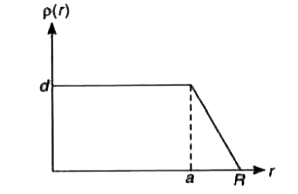The nuclear charge (Ze) is nonuniformly distributed within a nucleus of radius R. The charge density p(r) (change per unit volume) is dependent only on the radial distance r from the center of the nucleus as shown in figure, the electric field is only along the radial direction.The electric field within the nucleus is generally observed to be linerarly dependent on r. This implies
 Solution in Punjabi
Solution in Punjabi
a= 0
a = R/2
a = R
a = 2 R/3
Step by step video & image solution for The nuclear charge (Ze) is nonuniformly distributed within a nucleus of radius R. The charge density p(r) (change per unit volume) is dependent only on the radial distance r from the center of the nucleus as shown in figure, the electric field is only along the radial direction.The electric field within the nucleus is generally observed to be linerarly dependent on r. This implies by Physics experts to help you in doubts & scoring excellent marks in Class 12 exams.
Updated on:21/07/2023Topper's Solved these Questions
Similar Questions
A charge q is placed at the centre of line joining two equal charges Q. Show that the system of three charges will be in equilibrium if q = -Q/4
View SolutionFor current entering at A, the electric field E(r at a distance r form A
View SolutionTo get five images of a single object, one should have two plane mirrors at an angle of :
View SolutionThe nuclear charge ( Ze ) is non uniformlly distribute with in a nucleus of radius r. The charge density rho(r) (charge per unit volume) is dependent only on the radial distance r form the centre of the nucleus s shown in figure. The electric field is only along the radial direction. The electric field at r=R is
View SolutionThe nuclear charge (Ze) is non uniformly distributed within a nucleus of radius r. The charge density ρ(r) (charge per unit volume) is dependent only on the radial distance r form the centre of the nucleus as shown in figure. The electric field is only along the radial direction. For a=0 the value of d (maximum value of ρ as shown in the figure) is

View SolutionThe nuclear charge ( Ze ) is non uniformlly distribute with in a nucleus of radius r. The charge densilty rho(r) (charge per unit volume) is dependent only on the radial distance r form the centre of the nucleus s shown in figure. The electric field is only along the radial direction. The electric field within the nucleus is generaly observed to be linearly dependent on r. This implies
View SolutionThe electric field within the nucleus is generally observed to be linearly dependent on r. This implies.
View Solutionनाभिकीय आवेश (Ze), R त्रिज्या वाले नाभिक के भीतर असमान रूप से वितरित रहता हैं। आवेश घनत्व p(r) (अर्थात् एकांक आयतन में आवेश की मात्रा) नाभिक के केन्द्र से त्रिज्य दूरी (r) पर ही निर्भर करता है। वैद्युत क्षेत्र त्रिज्य दिशा के अनुदिश है।

दूरी r= R पर वैघुत क्षेत्र है।
View Solutionनाभिकीय आवेश (Ze), R त्रिज्या वाले नाभिक के भीतर असमान रूप से वितरित रहता हैं। आवेश घनत्व p(r) (अर्थात् एकांक आयतन में आवेश की मात्रा) नाभिक के केन्द्र से त्रिज्य दूरी (r) पर ही निर्भर करता है। वैद्युत क्षेत्र त्रिज्य दिशा के अनुदिश है।

a= 0 के लिए d (p का अधिकतम मान) का मान है।
View Solutionकिसी R त्रिज्या के नाभिक में नाभिकीय आवेश (Ze) आसमान रूप से वितरित है। आवेश घनत्व ρ(r) का वितरण नाभिक के केंद्र से दूरी के फलन के रूप में चित्र में प्रदर्शित है। विद्युत क्षेत्र सिर्फ अरीय दिशा में उपस्थित है।

सामान्यतया नाभिक के अंदर विद्युत क्षेत्र का r के साथ रैखिक सम्बन्ध पाया जाता है। इससे प्रदर्शित है कि
View SolutionThe nuclear charge ( Ze ) is non uniformlly distribute with in a nucleus of radius r. The charge density rho(r) (charge per unit volume) is dependent only on the radial distance r form the centre of the nucleus s shown in figure. The electric field is only along the radial direction. The electric field at r=R is
View SolutionThe nuclear charge ( Ze ) is non uniformlly distribute with in a nucleus of radius r . The charge density rho(r) (charge per unit volume) is dependent only on the radial distance r form the centre of the nucleus s shown in figure. The electric field is only along the radial direction. For a=0 the value of d (maximum value of rho as shown in the figure) is
View SolutionThe nuclear charge ( Ze ) is non uniformlly distribute with in a nucleus of radius r. The charge densilty rho(r) (charge per unit volume) is dependent only on the radial distance r form the centre of the nucleus s shown in figure. The electric field is only along the radial direction. The electric field within the nucleus is generaly observed to be linearly dependent on r. This implies
View Solutionत्रिज्या R के एक नाभिक में नाभिकीय आवेश (Ze) असमान रूप से वितरित है चित्रानुसार, आवेश घनत्व ρ(r) [प्रति इकाई आयतन आवेश] नाभिक के केंद्र से त्रिज्यीय दूरी r पर निर्भर करता है विधुत क्षेत्र केवल त्रिज्यीय दिशा के अनुदिश है।

r=R पर विधुत क्षेत्र है
View Solutionत्रिज्या R के एक नाभिक में नाभिकीय आवेश (Ze) असमान रूप से वितरित है चित्रानुसार, आवेश घनत्व ρ(r) [प्रति इकाई आयतन आवेश] नाभिक के केंद्र से त्रिज्यीय दूरी r पर निर्भर करता है विधुत क्षेत्र केवल त्रिज्यीय दिशा के अनुदिश है।

a=0 के लिए, d का मान (चित्रानुसार ρ का अधिकतम मान) है
View Solutionत्रिज्या R के एक नाभिक में नाभिकीय आवेश (Ze) असमान रूप से वितरित है चित्रानुसार, आवेश घनत्व ρ(r) [प्रति इकाई आयतन आवेश] नाभिक के केंद्र से त्रिज्यीय दूरी r पर निर्भर करता है विधुत क्षेत्र केवल त्रिज्यीय दिशा के अनुदिश है।

नाभिक के अन्दर यह देखा गया है विधुत क्षेत्र सामान्यतः रेखिक रूप से r पर निर्भर करता है यह व्यक्त करता है।
View Solution
